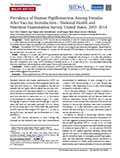Clinician Factsheets and Guidance
CDC now recommends 11 to 12 year olds get two doses of HPV vaccine—rather than the previously recommended three doses—to protect against cancers caused by HPV. The second dose should be given 6-12 months after the first dose. For more information on the updated recommendations, read the MMWR: https://www.cdc.gov/mmwr/volumes/65/wr/mm6549a5.htm.
What can you do to ensure your patients get fully vaccinated?
Use every opportunity to effectively recommend and administer all of the adolescent vaccines to parents of your preteen and teen patients. Parents trust your opinion more than anyone else’s when it comes to immunizations. Use the resources to help you make effective recommendation and answer questions to help parents overcome HPV vaccine hesitancy.
Take Action By:
- Avoiding missed opportunities to administer HPV vaccine—effectively recommend the HPV vaccine the same way and on the same day that you recommend other adolescent vaccines.
- Educating parents about the diseases that can be prevented by adolescent vaccines and talking about HPV vaccination in terms of cancer prevention.
- Learning how to communicate successfully about HPV vaccination and how to answer a variety of questions from parents about HPV vaccine.
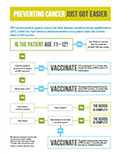
The decision tree is an easy to follow chart that can help you determine whether your patient needs two or three doses of HPV vaccine.

CDC now recommends 11 to 12 year olds get two doses of HPV vaccine—rather than the previously recommended three doses—to protect against cancers caused by HPV. The second dose should be given 6-12 months after the first dose.
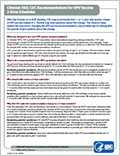
CDC now recommends that 11 or 12 year olds receive 2 doses of HPV vaccine instead of 3. This resource helps explain the reasons for changing the HPV vaccine recommendation, and provides tips for talking with the parents of your patients about the change.
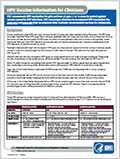
This resource provides information about the background of HPV vaccine, recommendations, safety, effectiveness, and duration of protection. It also provides information on dosing schedules around the 2-dose recommendation.

This resource provides background on 9-valent HPV vaccine as well as how to move forward with using it in your practices.
In a recent article in The Journal of Infectious Diseases the authors used data from the National Health and Nutrition Examination Survey (NHANES) to compare HPV prevalence before and after the introduction of HPV vaccination.

This resource offers a top ten list of ways that you can use to help attain and maintain high HPV vaccination rates.
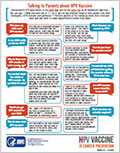
Use this resource to find effective ways to answer the questions that parents have about HPV vaccination
- Page last reviewed: March 10, 2017
- Page last updated: August 21, 2017
- Content source:


 ShareCompartir
ShareCompartir
